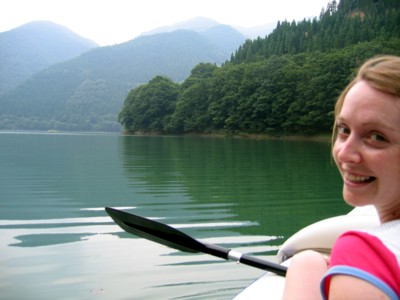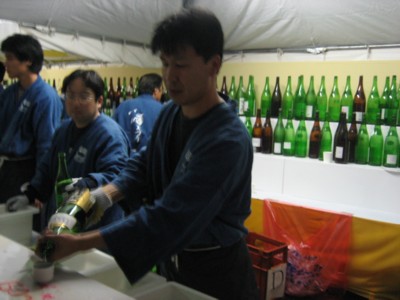Monday, October 24, 2005
Fukui is rapidly cooling off as we move into Autumn, and make way for what I hope will be another cold, snowy winter. Making the most of the pleasant temperatures, I’ve been cruising the great lakes of Ono as much as possible, before the snows make the little travelled access roads impassable.
Last week, whilst cruising the lake, my American friend Caitlin and I were lucky enough to stumble upon a band of wild monkeys. Despite my many expeditions out to the lakes, I haven’t seen any monkeys since my very first venture back in July (see archives for monkey pictures), when I managed to get fairly close to these inquisitive creatures.
Both of the lakes I visit are dam controlled, and they must have released a huge amount of water recently, as the levels have dropped by a good twenty meters since my last trip, which exposes the banks, churns up the water and unfortunately makes them look a little less picturesque overall.
I may well have had the last Sea Eagle ride of the season. Last Saturday, I paddled out into Lake Kuzuryu only for the skies to open and dump a heavy load of rain on me, completely soaking me to the bone. After scrambling up the steep banks and ploughing through the undergrowth with my boat in tow, I emerged bedraggled and muddy. However, the boat received a good clean down in preparation for its winter hibernation and after thorough testing on the sea and freshwater, I yet again fully recommend the Sea Eagle 330 as a well made and excellent value craft.
Thursday, October 13, 2005
Last weekend Japan was blessed with yet another national holiday, which saw a small group of us head south to the city of Hiroshima. We took the famed bullet train, which although fast, was very expensive, the 4 hour return journey setting us back some Y30,000 (£150)!
In the past, I’ve often commented on Japan being wrongly labelled as an expensive country, but when it comes to public transport, it deserves everything it gets. Granted, trains are very punctual, but I have a couple of gripes about the Japanese rail system which I will briefly air with you.
Firstly, even though the bullet trains are incredibly long, each normally pulling some 14 carriages, there is rarely more than two which are non reserved. Reserving a seat costs yet more money, the result of which is that there are a lot of people trying to sit on not a lot of seats. We spent the majority of the trip standing or sitting on the floor, in between carriages, or in luggage racks, despite there being many free seats in the reserved carriages.
The other thing that annoys me is the amount of tickets they give you. For this simple return journey, we each were handed 6 tickets, various combinations of which have to be shown at the numerous checkpoints, and fed into the ticket machines. I am now especially conscious of this after a ticket mistake (which was only partially my fault) coming back from Tokyo this summer, ended up costing me another Y8000 (£40), on top of the £150 I’d already paid. Needless to say, that wasn’t my favourite day in Japan.
Hiroshima needs little introduction, but although most people know that America dropped a nuclear bomb on the city during the WW2, I was ignorant of the finer details of story. So, we ascertained a good education of the history of the attack at the Hiroshima Atomic Bomb Museum, which chronicles the lead up to, the day of, and the aftermath of the bomb.
I felt much more self conscious as a foreigner in Hiroshima than I have felt before in Japan. Despite none of our party of six actually being American, I am well aware of the Japanese assumption that any foreign Caucasian is from the U.S.A. In an opening conservation with a new Japanese person, never have I been ask if I was from Australia, Canada or England – the first guess is always: “America?”.
Of course, even if we had been American, it should have made no difference, after all, the events are now six decades in the past, and most young Japanese seem to be enamoured with American culture. However, I couldn’t help wondering if there was perhaps still some deep seated resentment towards Americans, harboured amongst the citizens of Hiroshima, especially from the older generations who may have themselves experienced the unimaginable horrors of that terrible day, back in August 1945.
And terrible it was; the lone bomb, that measured a mere 3 meters in length, released such a huge amount of atomic energy, that for several hundreds of meters around the explosion, the temperature rose to 3000C in 3 seconds, and completed incinerated everything. The people who died instantly we perhaps the lucky ones, as those caught further from the epicentre, were subjected to horrible blistering burns, their skin melting, and flaying off, yet still alive. With hospitals and medical supplies largely destroyed, there was little hope for the injured, and many just lay in the streets, suffering terribly from their burns, with no one to comfort them as they passed away.
Some 80,000 people died in the blast, almost 95% of whom were civilians and thousands more perished over the following weeks due to incurable injures. In later months and years, still more secumbed to various disfiguring cancers caused by the radiation, leaving the total death toll at approximately 120,000. Despite all the wars before and after, never have so many people been exterminated so quickly by a single attack on a nation.
In the museum itself we wandered round the exhibits, listening to the sad account on our headsets, and eyeing the gruesome exhibits displaying pictures of burned bodies and flattened buildings. There was an understandably sombre air to the place, and we had little desire to make light talk, meaning that for the entire 2 hours duration of our visit, none of us spoke, each lost in our own private thoughts.
A large portion of the museum is devoted to the future of nuclear disarming, though it admitted itself, that despite the horrors, at the present time there was little progress being made and the future looked bleak.
Despite the heavy air that surrounds these events, Hiroshima city is also testament to how a city can rebuilt and people can live on, even after such devastation and pain. Indeed, Hiroshima is now indistinguishable from any other Japanese city; its grey high rise buildings stretching to the mountains in every direction. As we sat in the loft area of a funky little bar, 5 floors up, overlooking the neon city, it was incredible to think that just 60 years ago, every single building within a mile radius of where we now sat, was completely destroyed, leaving nothing but a few tree trunks, and a mass of charred rubble.
So as to balance the weekend with a lighter air, we visited the nearby island of Miya-jima. Populated by tame monkeys and ravenous deer who greedily consumed our map and paper napkins, we scaled a small forested mountain and took in the views of the surrounding islands out to sea.
We also visited a sake (rice wine) festival, where all the brewers from every corner of Japan congregated to show off their finest vintage, and for a mere Y1500 (£7.50) you could drink all you wanted all day, a bargain we couldn’t resist, which lead to a somewhat blurry, yet enjoyable evening.
Overall, a solid trip, and though expensive, it was well worth the price, and it’s always good to escape from Fukui for a few days.
Thursday, October 06, 2005
You may have noticed that posts on thefunkydrummer have been a little thin on the ground over the last week or two. Well, I have two words for you: SNOW SPHERE. At the expense of all else, I am currently pouring all my energy into the creation of a new project, which is sure to become even more massive than jungle in the future. And jungle was massive.
So what is this spherical ball of snow of which I speak? Well, Snow Sphere, or Snow Sphere Magazine I should say, has been created by yours truly to fill a gap in the magazine market. The idea behind Snow Sphere is to feature interesting and inspiring snow stories about the less well ridden slopes of the globe, be it backcountry in Bolivia, (what... you didn't even know Boliva had a ski resort?) or a backyard in London.
The monthly mag will start its life in electronic form, but who knows what the future may bring? Already Snow Sphere has recieved a flood of very interesting snow stories and ideas, which I am very much looking forward to presenting to you in Snow Sphere form for your reading pleasure.
Unfortunately, the development of Snow Sphere has come at a price. I had signed myself up for a Japanese exam, in the hopes that the pressure would motivate me to study more. At first it did, and I became absorbed in the Nihongo, but then Snow Sphere came along and suddenly, learning all the negative forms of the group two verbs, and trying to memorise complicated grammar particles, ceased to appeal.
Instead, reading about a snow road trip in Chile, or an account of shredding the himalyas was just too tempting.
If you have an interesting snow story to tell and would like to get published in Snow Sphere Magazine, check out www.snowsphere.com for the writers guidlines.
Nihongo benkyo shimasu R.I.P.












